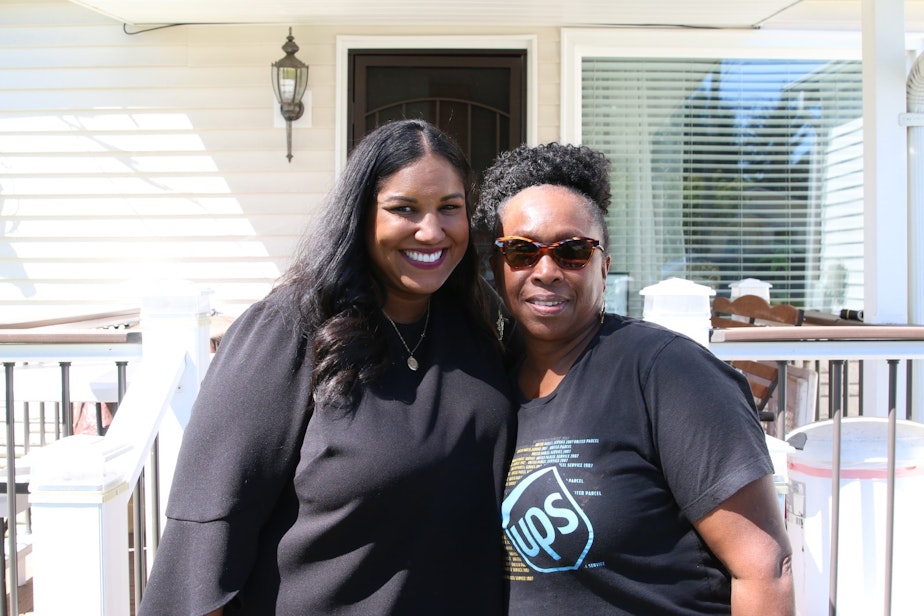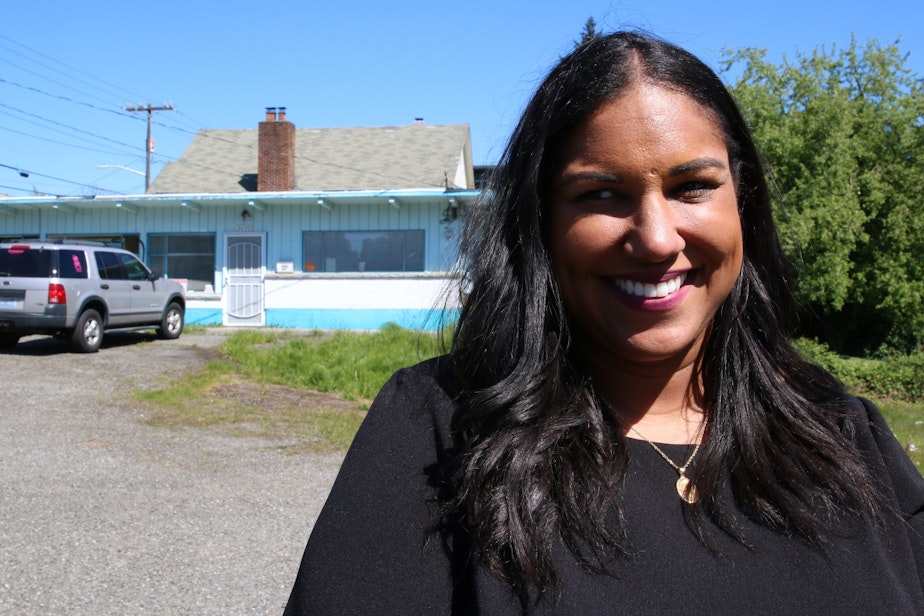In Rainier Beach, home owners hope to survive Seattle upzones

Rainier Beach: the neighborhood where the promise and the threat of growth is most apparent in Seattle.
Seattle’s new affordable housing rules mean that upzones are now in effect throughout much of the city. Developers can now build more homes on less land. In exchange, they have to contribute to affordable housing. The downside is that in some neighborhoods, there’s a risk development will push people out. That’s a real concern in Seattle’s Rainier Beach neighborhood.
Cabby Albright grew up in Rainier Beach. “And my childhood house, is right here,” she said, pointing to a modest split-level home. “It looked a lot cuter when I lived there,” she said.
Albright said her family settled in Rainier Beach when she was a little kid, after a wave of gentrification pushed them out of the Central District. The memory of being displaced has stayed with her. “I think the Central District was really a failure for the city of Seattle," she said. "I think we failed a lot of people in that whole entire community.”
Albright doesn’t want to see a repeat of that kind of gentrification drive her Rainier Beach neighbors out. “I don’t like it when people are taken advantage of," Albright said. "And I feel like, in real estate, a lot of people can easily get taken advantage of.”
So Albright became a real estate agent. And when she stops by to visit her old neighbor Mary Gilbert, the topic of real estate comes up. Gilbert asked Albright about rumors she'd heard that the area had been upzoned.
Sponsored
“Yep, they rezoned it," answered Albright.
“That sucks!" said Gilbert. "I hope nobody sells anytime soon.”
“Oh, they’re probably going to start selling,” said Albright.

Sponsored
Gilbert said she has no interest in leaving. She has 10 grandkids within a short driving distance. “I’m not going anywhere. I’ve been here for over 30 years. It’s the type of house I like. I’m not trying to get into something that’s going up like this," she said, gesturing towards the sky with her hand. "They’re just going to have to build around me.”
But here’s the thing: Mary Gilbert may be able to do a lot more with her property now. Cabby Albright tells her that, on first glance, it looks like she could now legally build three houses on her lot. Today, there’s only one.
Gilbert appears to consider the idea, then says, “The most I would do would be to build something in the back. You know, just for a rental or whatever.”
“You know, you have a lot of kids. You have a lot of grandkids," said Albright. "If you decided you wanted to build a house for Sheena on your lot, you could. You could put 3 houses on your lot. And have your whole family living on one lot, in Seattle. You could decide to do that.”
“And that would make a lot of sense… you know, to do that,” Gilbert responded.
Sponsored
But Albright said there are obstacles, too, to be aware of. “It’s not cheap to do," she said. "To build 3 houses is not a cheap thing to do.”
Meanwhile, the pressure to do something rises, because property taxes are going up. Those taxes are based on market value of a property, which is based on what the land could be – not what they are now. The idea is to nudge along development slightly so there's a systemic bias towards the creation of more housing.
But this creates a trap people for some people. The upzones offer value, but only if you can take advantage of it.
Developing land costs money. And money can be hard to come by in lower income neighborhoods like Rainier Beach.
That’s why a city analysis of Seattle’s growth plan said there’s a high risk of displacement there. It said further measures might be needed to protect people in the area.
Sponsored

Lance Randall is with SEED, a non profit that promotes equitable development.
“Well, I’ve seen cases where I’ve seen people want to do some development of their own property – but when they try to get financing for it – they’re turned down,” said Randall.
He said people get turned down for loans because they don’t have enough income, and they don’t have the extra 3 hundred thousand dollars in cash they need for a down payment. “So it makes it very difficult for many of them to do anything with their properties,” he said.
He wants governments to do more to protect low income property owners from property tax increases. He says the state could choose to hold off on reassessing a property until the owner tries to develop it.
Sponsored
One of the things Seattle did to minimize the impact on neighborhoods like Rainier Beach was to impose higher MHA (Mandatory Housing Affordability) fees on developers who take advantage of upzones. That could hold development back a little bit, giving the neighborhood more time to adjust to coming density. But the higher fees could backfire if they allow only wealthy property owners to develop and make redevelopment more expensive and therefore more impractical for lower income homeowners .

A more realistic option for homeowners like Mary Gilbert might be for her to build a backyard cottage. Legislation making its way through the council would liberalize rules around construction of backyard cottages and basement granny flats, and exempt them from MHA fees.
Cabby Albright sees a big difference from the way Rainier Beach is changing - and the way the Central District changed, years ago. In the Central District, she said, developers upzoned land one parcel at a time, engaging in a complex, expensive process that involved making a case for their project before the city council.
The difficulty of that process meant it was unavailable for most homeowners. Albright said developers with access to these processes were able to make lowball offers on Central District homes, knowing those homeowners could not access the full value of their properties.
In contrast, Albright said she celebrates the relative transparency and uniformity of Seattle's recent upzones. It's much harder for a developer to low ball an offer when everyone knows about the potential of their property.
Albright said the recent upzones will help Rainier Beach improve, but only if people can take advantage of the opportunities.
So she talks to her neighbors about real estate; she wants them to know what they’re allowed to do – and what they’re up against.
Correction: An earlier version of this story misspelled Mary Gilbert's last name.




